Key takeaways:
- Establishing a sense of belonging and shared values in workshops fosters trust, collaboration, and deeper learning experiences among participants.
- Creating inclusive environments through open discussions, respect for diversity, and varied learning styles enhances engagement and connection.
- Nurturing community beyond workshops through casual meetups, follow-up communication, and ongoing projects strengthens relationships and encourages continued support among participants.
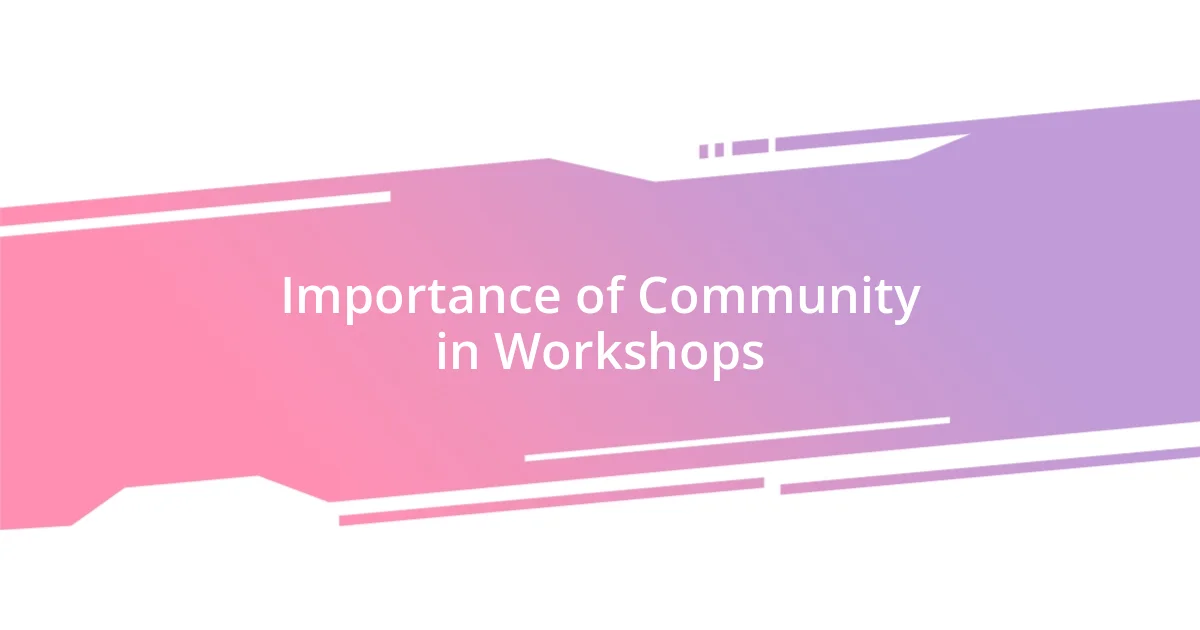
Importance of Community in Workshops
When I reflect on the power of community in workshops, I can’t help but think back to a session I attended years ago. The facilitator asked us to share our personal stories, and that simple act created an atmosphere of trust and openness. It struck me how vulnerable we all felt yet how connected we became in that moment—why is it that sharing our experiences can turn strangers into a supportive network so quickly?
The sense of belonging is crucial in a workshop setting. Participants are more likely to engage and contribute when they know they are part of something larger. Imagine being surrounded by others who share similar struggles and aspirations—doesn’t that just make you feel more motivated to express yourself? That camaraderie can often lead to richer discussions and a deeper learning experience.
Moreover, the shared learning environment fosters creativity and collaboration. I remember participating in a brainstorming session where ideas flowed freely among us, and it felt electric. Each person’s input felt valued, and suddenly we were building solutions together. How often do we find ourselves stifled, doubting our ideas in isolation? Recognizing that we’re stronger together not only enhances our workshops but also leaves us feeling empowered beyond the session.
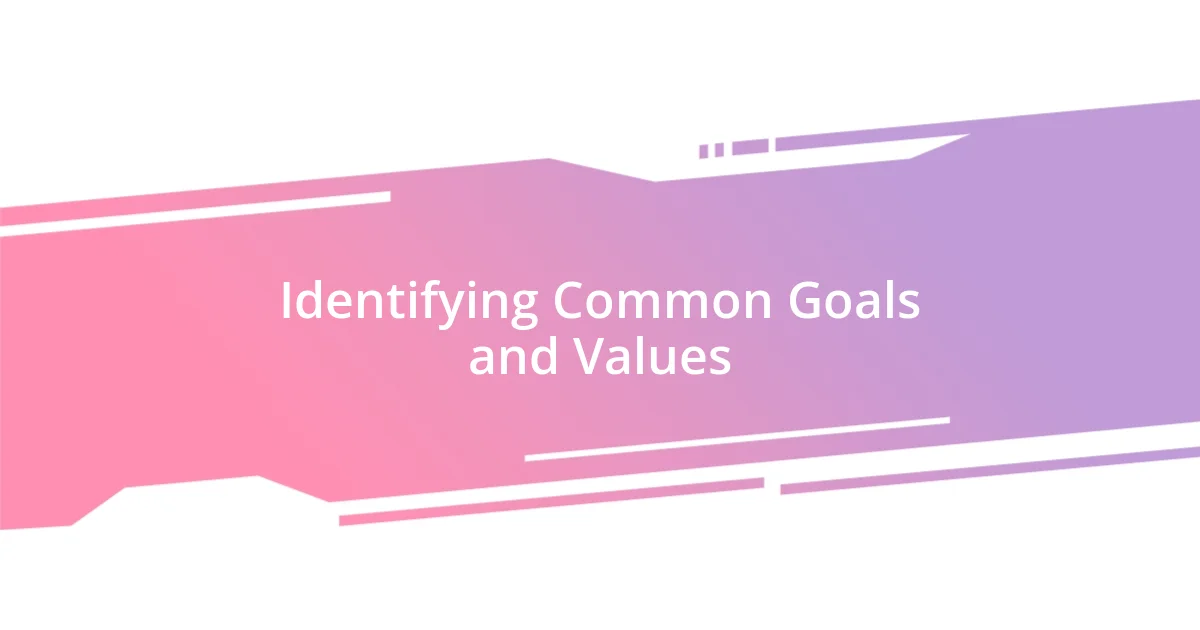
Identifying Common Goals and Values
Finding common goals and values within a workshop can be a transformative experience. I recall a workshop where we collectively defined what success looked like for us. Seeing how everyone’s individual aspirations wove together into a broader vision was enlightening. It fostered a sense of unity and purpose, creating a space where we all felt accountable to each other.
To effectively identify these shared goals and values, consider these steps:
- Facilitate Open Discussions: Encourage participants to share what they hope to achieve. This helps unearth underlying themes.
- Use Visual Aids: I once used a mind map to capture everyone’s goals. It was fascinating to see connections emerge as we spoke.
- Prioritize Key Themes: Once ideas are laid out, collaboratively discuss and prioritize the most resonant themes. This empowers everyone and ensures that no voice is overlooked.
By engaging in these practices, participants can align their objectives, fostering a deeper, more cohesive workshop community.
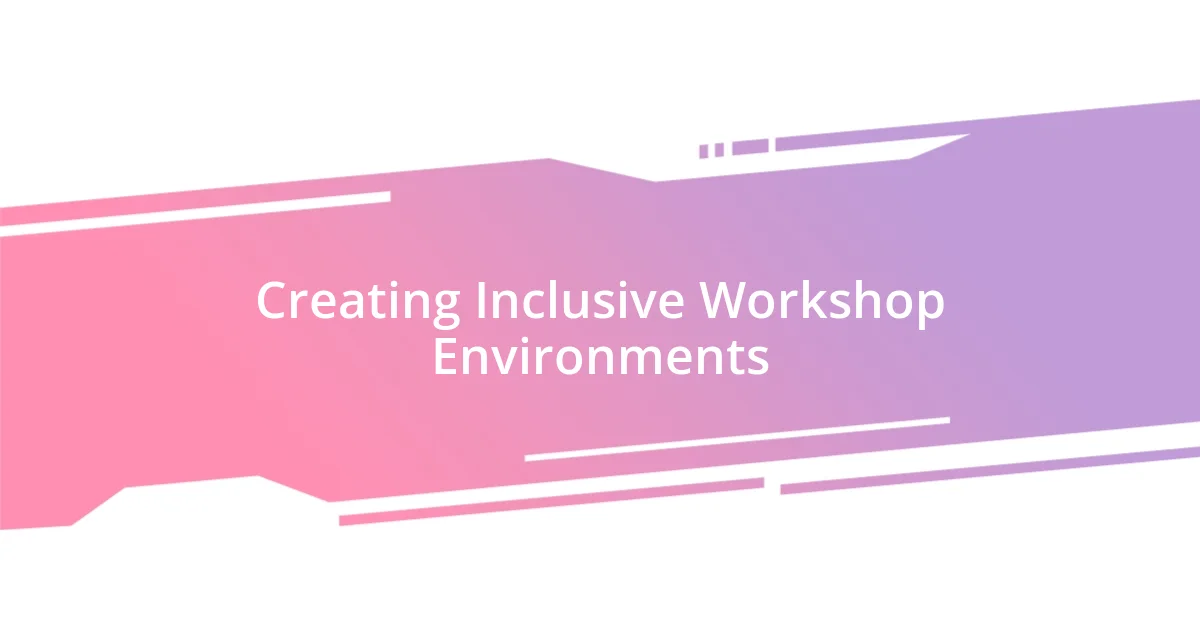
Creating Inclusive Workshop Environments
Creating inclusive environments in workshops is pivotal for nurturing connection and engagement. I once facilitated a workshop where we started with a simple icebreaker: sharing our names and what brought us there. It was heartwarming to hear the unique stories each participant brought, and instantly, barriers began to dissolve. Ensuring everyone feels seen and heard from the beginning establishes inclusivity; it reminded me of how powerful our voices can be when shared in a welcoming space.
I also believe that respecting diverse backgrounds and perspectives is essential. During a workshop I participated in, we had a mix of attendees from different cultures. At first, I worried that this diversity might lead to misunderstandings. Instead, it enriched our discussions as each person offered distinct viewpoints. I learned that creating an inclusive space meant facilitating dialogue that allowed for differences—paving the way for greater understanding and collaboration.
Furthermore, providing accessible materials and accommodating various learning styles is crucial. Once, I worked in a workshop where materials were presented only in a lecture format. Many participants struggled to engage. So, the next time, we introduced varied learning strategies: visuals, hands-on activities, and small group discussions. It was like flipping a switch. Participants who once seemed disengaged began to thrive! Being proactive in how we present information can cater to everyone, making the experience more impactful for all involved.
| Inclusive Practice | Impact |
|---|---|
| Facilitating Open Discussions | Encourages safe expression of diverse thoughts |
| Using Visual Aids | Enhances understanding and engagement |
| Respecting Diverse Backgrounds | Fosters richer collaboration |
| Adapting Learning Styles | Ensures everyone can participate meaningfully |
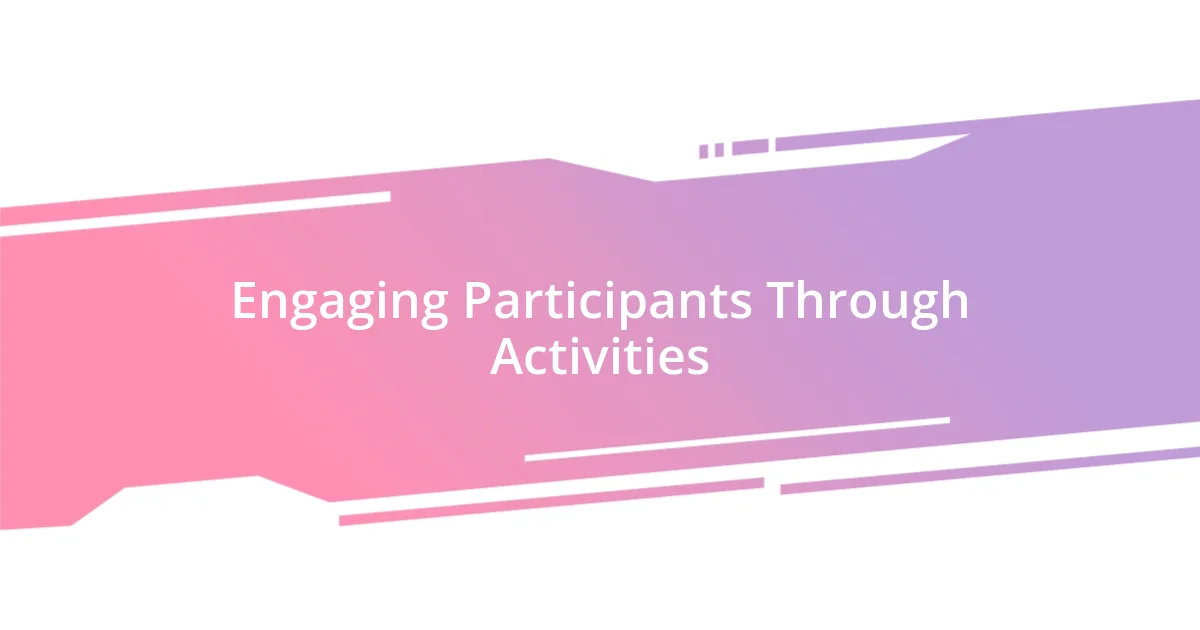
Engaging Participants Through Activities
Engaging participants in workshops isn’t just about what we share; it’s about how we connect through activities. I remember a time when I organized a team-building exercise that involved problem-solving tasks. Watching participants laugh and strategize together made me realize how these collaborative moments not only built skills but also forged friendships. Isn’t it fascinating how a simple activity can break down walls and encourage genuine collaboration?
I often use hands-on activities to spark enthusiasm among attendees. For instance, we once did a creative brainstorming session where everyone had to construct a model with limited resources. The energy in the room was contagious! Participants were not just sharing ideas; they were physically embodying their thoughts. This reminded me how active participation fosters ownership of the learning process. Have you ever witnessed the shift in atmosphere when people engage in an unexpected way?
Lastly, I’ve seen how arts and crafts can serve as an unexpected bridge in workshops. During one session, we crafted vision boards that represented our goals as individuals and as a group. As we cut, glued, and shared our ideas, the environment transformed into one of shared vulnerability and support. It was powerful to see participants open up, revealing dreams and fears they hadn’t previously voiced. Activities like these create a sense of community that often lasts well beyond the workshop itself. How can we incorporate more creative elements to help others express themselves?
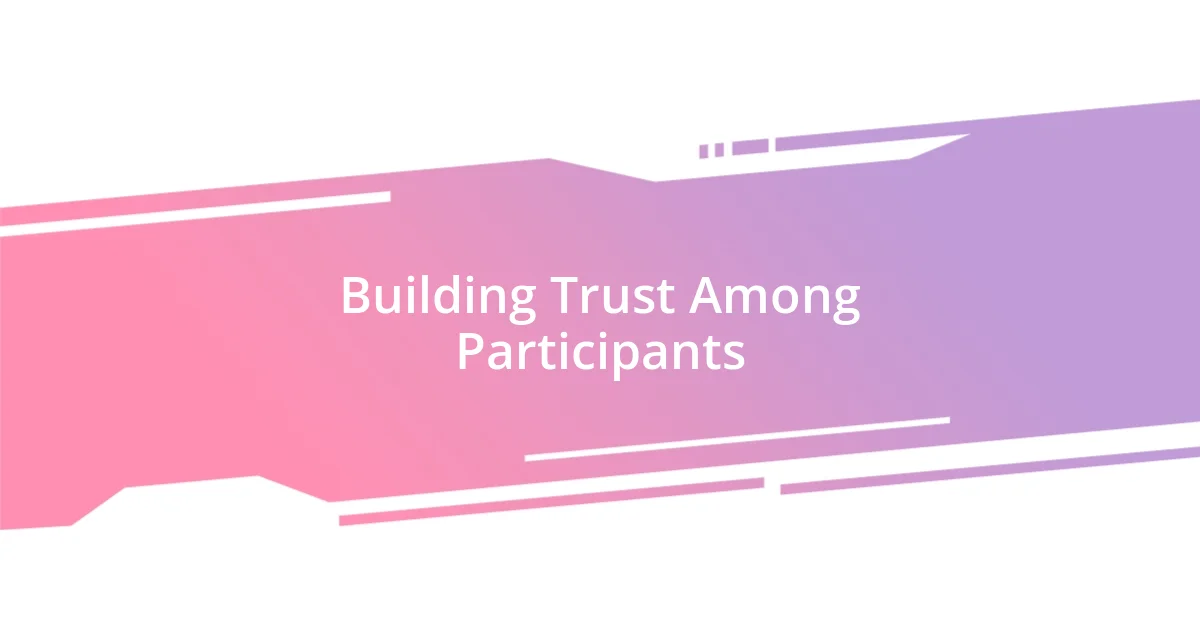
Building Trust Among Participants
Building trust among participants is truly foundational for any workshop. In one memorable experience, I noticed how sharing personal stories during a trust-building exercise fostered an intimate atmosphere. Participants began to open up, revealing vulnerabilities that connected them in ways I hadn’t anticipated. Isn’t it amazing how being authentic can create a sense of belonging?
One strategy that has worked wonders for me is establishing ground rules together at the beginning of a workshop. I remember a session where we collectively agreed on confidentiality and respect. This simple act empowered participants, making them feel more secure to voice their thoughts. It’s essential to ask how everyone can contribute to creating a safe space—what might be their expectations?
Lastly, I believe in the power of small groups. During a workshop, I divided participants into pairs for deeper discussions. This change allowed them to dive into topics they were hesitant to share in larger settings. The intimate conversations led to genuine connections that lingered long after the workshop ended. Have you ever noticed how much more people are willing to share in smaller circles?
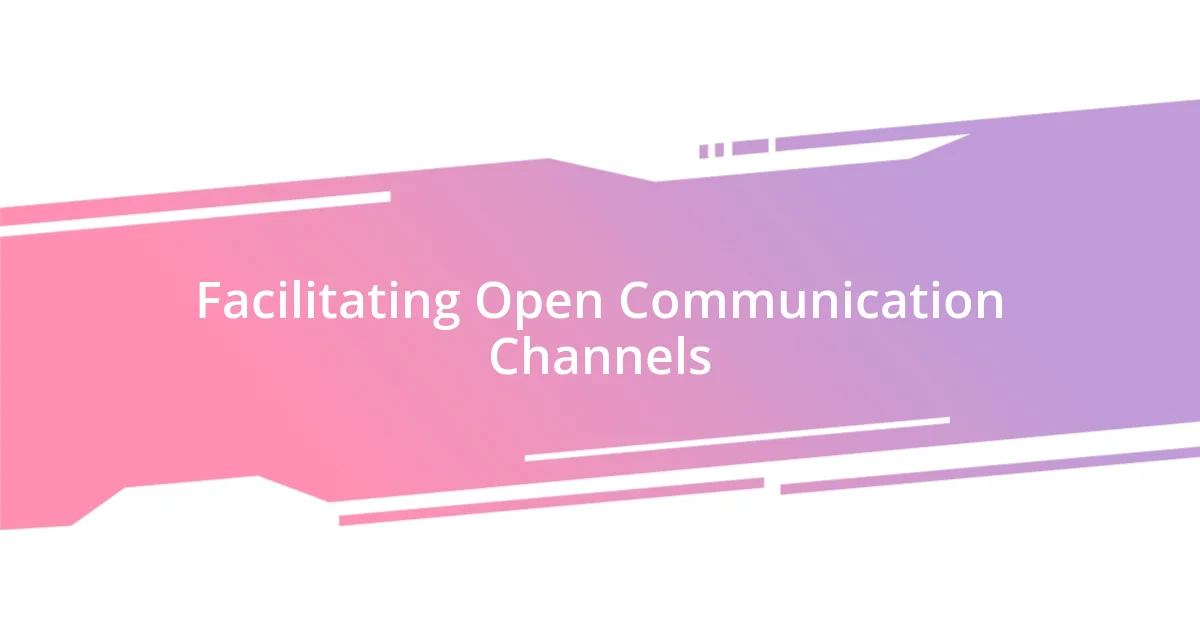
Facilitating Open Communication Channels
Facilitating open communication channels in workshops is essential for fostering a collaborative environment. I clearly remember a time when I used anonymous question cards, allowing everyone to submit their thoughts without fear of judgment. The air buzzed with excitement as participants eagerly engaged in discussions about their questions. It was eye-opening to witness how this simple approach encouraged voices that might otherwise remain quiet. Have you ever thought about how anonymity can spark honesty?
Another approach I’ve found effective is using digital platforms to keep lines of communication open before, during, and after workshops. In one instance, I created an online forum for a group project, allowing participants to collaborate on ideas simultaneously. This technological bridge enabled real-time feedback and built a sense of community that extended the workshop experience. Isn’t it intriguing how technology can enhance personal interactions in such meaningful ways?
Lastly, I strongly believe in the importance of regular check-ins throughout the workshop. I make it a point to pause and invite feedback after each session. It was during one of these moments that a participant shared their apprehension about speaking up, leading to an inspiring group discussion where others expressed similar feelings. These candid check-ins not only validate emotions but also cultivate a culture of openness. How often do we take the time to truly connect and understand where everyone is coming from?
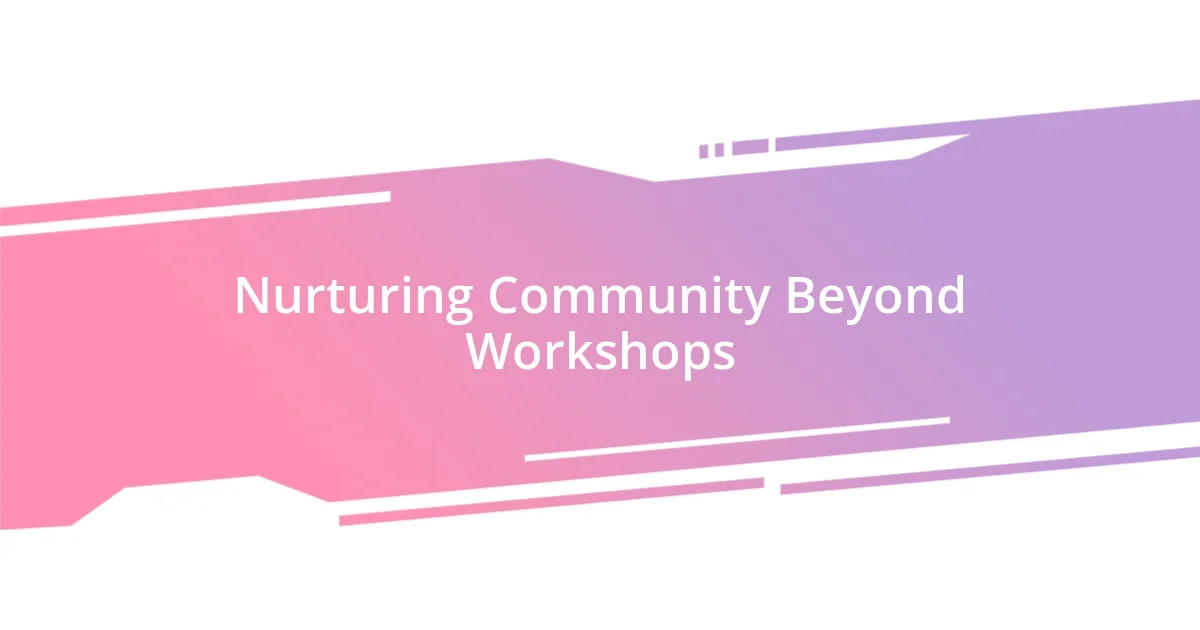
Nurturing Community Beyond Workshops
Nurturing community beyond workshops is a journey I genuinely cherish. I recall organizing a casual meetup a month after a particularly impactful workshop; it transformed the dynamic among participants. They were now not just acquaintances but friends, sharing laughter over coffee and brainstorming future collaborations. Isn’t it interesting how these informal gatherings can deepen connections that developed during more structured sessions?
I also make it a point to send out follow-up emails, not just to solicit feedback but to share resources or articles related to our workshop discussions. I remember getting a heartfelt reply from a participant who appreciated that I thought of them. It’s these little gestures that remind participants they are valued and that their growth matters beyond the confines of the workshop. How often do we check in on our peers’ journeys and support them personally?
Establishing ongoing collaborative projects can be incredibly rewarding as well. For example, I initiated a monthly book club with past workshop attendees, and the discussions often echo the themes we explored during our time together. Participants not only engage with the material but also support one another in applying these concepts in real life. Isn’t it incredible how shared interests can keep the spirit of community alive long after we’ve left the workshop space?














